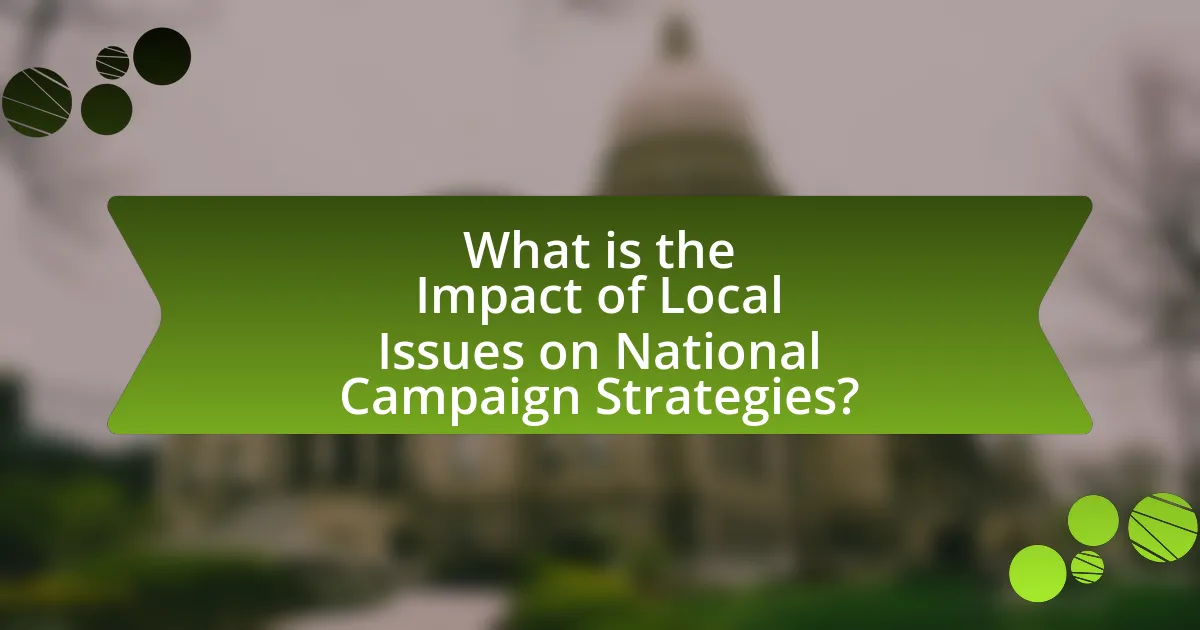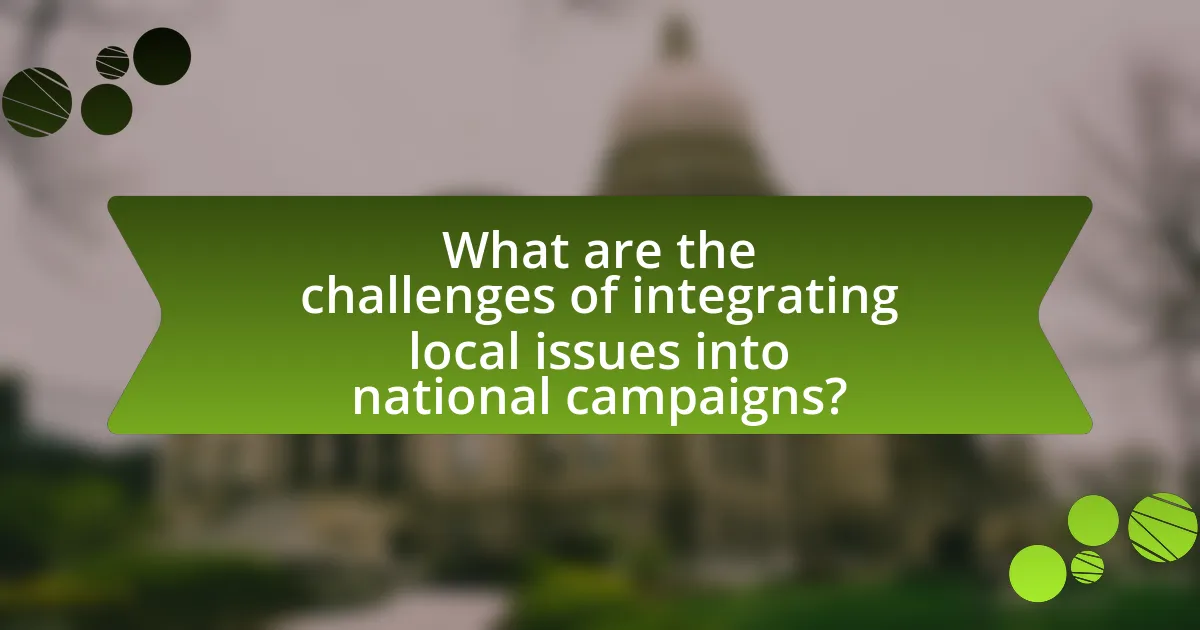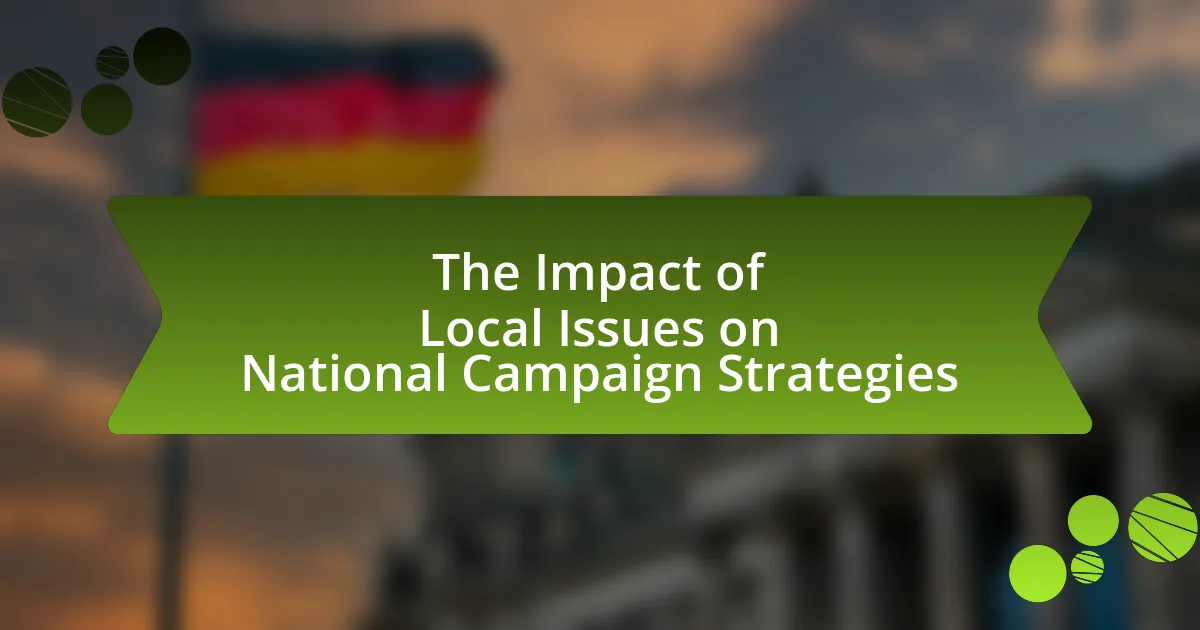The article examines the significant impact of local issues on national campaign strategies, highlighting how candidates adapt their platforms and messaging to resonate with voters’ immediate concerns. It discusses the influence of local issues on political discourse, voter priorities, and campaign funding, emphasizing the necessity for national campaigns to align with local contexts to enhance voter engagement. Key examples, such as the Flint water crisis and the Black Lives Matter movement, illustrate how local issues can gain national attention and shape electoral outcomes. The article also addresses the challenges campaigns face in integrating local issues and offers strategies for effectively communicating these concerns to a broader audience.

What is the Impact of Local Issues on National Campaign Strategies?
Local issues significantly influence national campaign strategies by shaping candidates’ platforms and messaging to resonate with voters’ immediate concerns. For instance, during the 2020 U.S. presidential election, candidates tailored their approaches to address local issues such as healthcare access, economic recovery, and racial justice, which were pivotal in swing states. Research indicates that candidates who effectively align their national narratives with local priorities tend to garner greater support, as evidenced by Joe Biden’s focus on COVID-19 response in key battleground areas. This alignment demonstrates that national campaigns must adapt to local contexts to enhance voter engagement and electoral success.
How do local issues influence national political discourse?
Local issues significantly influence national political discourse by shaping the priorities and narratives that candidates adopt during campaigns. For instance, when local communities face challenges such as healthcare access or education funding, these issues often gain traction at the national level as candidates address them to resonate with voters. A notable example is the 2018 midterm elections, where candidates emphasized local concerns like gun control and immigration, reflecting constituents’ sentiments and driving national conversations. This alignment between local issues and national discourse can mobilize voter turnout and impact election outcomes, demonstrating the interconnectedness of local and national political landscapes.
What are examples of local issues that have gained national attention?
Examples of local issues that have gained national attention include the Flint water crisis, which highlighted the dangers of lead contamination in drinking water, and the Black Lives Matter movement, which originated from local incidents of police violence but sparked nationwide protests and discussions on systemic racism. The Flint water crisis began in 2014 when the city switched its water source, leading to widespread lead exposure among residents, drawing significant media coverage and prompting federal intervention. Similarly, the Black Lives Matter movement gained traction after the 2014 shooting of Michael Brown in Ferguson, Missouri, leading to a national dialogue on police reform and racial justice, influencing political campaigns and policies across the country.
How do local issues shape voter priorities in national elections?
Local issues significantly shape voter priorities in national elections by influencing how candidates address constituents’ immediate concerns. For instance, when local economies struggle, voters prioritize candidates who propose job creation and economic revitalization plans. A study by the Pew Research Center found that 62% of voters consider local economic conditions when deciding their national vote, indicating a direct correlation between local issues and national electoral outcomes. This demonstrates that candidates who align their national platforms with local priorities can effectively mobilize support and resonate with voters’ immediate needs.
Why are local issues critical in shaping campaign strategies?
Local issues are critical in shaping campaign strategies because they directly influence voter priorities and engagement. Campaigns that address specific local concerns, such as education, healthcare, or infrastructure, resonate more with constituents, leading to increased voter turnout and support. For instance, a study by the Pew Research Center found that 62% of voters consider local issues as a significant factor in their voting decisions, demonstrating the importance of tailoring campaign messages to reflect community needs. By focusing on local issues, candidates can build stronger connections with voters, ultimately enhancing their chances of electoral success.
What role do local issues play in candidate messaging?
Local issues significantly shape candidate messaging by allowing candidates to connect with voters on a personal level and address specific community concerns. Candidates often tailor their messages to highlight local issues, demonstrating their understanding of the electorate’s needs and priorities. For instance, a candidate running for office in a region affected by economic decline may focus on job creation and local business support, which resonates with constituents facing unemployment. Research indicates that candidates who effectively incorporate local issues into their messaging can increase voter engagement and support, as seen in the 2020 U.S. elections where candidates emphasized local healthcare access and education funding to appeal to voters’ immediate concerns.
How do local issues affect campaign funding and resource allocation?
Local issues significantly influence campaign funding and resource allocation by directing financial support towards candidates who prioritize those specific concerns. For instance, when a community faces pressing issues such as education, healthcare, or infrastructure, candidates often tailor their platforms to address these needs, attracting donations from local stakeholders and organizations invested in those areas. According to a study by the Center for Responsive Politics, local issues can lead to increased contributions from local businesses and interest groups, as they seek to support candidates who align with their interests. This targeted funding allows candidates to allocate resources effectively, focusing on outreach and campaign strategies that resonate with local voters, thereby enhancing their chances of electoral success.

How do political parties adapt their strategies based on local issues?
Political parties adapt their strategies based on local issues by tailoring their messaging, policy proposals, and campaign tactics to resonate with the specific concerns of constituents in different regions. For instance, a party may focus on economic development in a region facing high unemployment, while emphasizing environmental policies in areas affected by pollution. This localized approach is supported by research indicating that candidates who align their platforms with local priorities tend to perform better in elections. A study by the Pew Research Center found that 62% of voters consider local issues more important than national issues when making their voting decisions, highlighting the necessity for parties to adjust their strategies accordingly.
What strategies do national campaigns employ to address local concerns?
National campaigns employ targeted messaging, local endorsements, and grassroots mobilization to address local concerns. Targeted messaging involves tailoring campaign communications to resonate with specific local issues, such as economic development or healthcare access, which can be evidenced by campaigns that highlight local success stories or challenges. Local endorsements from community leaders and organizations enhance credibility and demonstrate a commitment to local needs, as seen in various campaigns that secure support from influential local figures. Grassroots mobilization engages local volunteers and constituents, fostering community involvement and ensuring that campaign efforts reflect the priorities of local voters, a strategy effectively utilized in numerous successful electoral campaigns.
How do campaigns tailor their platforms to resonate with local voters?
Campaigns tailor their platforms to resonate with local voters by focusing on specific regional issues, cultural values, and community needs. They conduct extensive research, including surveys and town hall meetings, to identify the priorities of local constituents. For instance, a campaign may emphasize job creation in areas with high unemployment rates or advocate for local environmental policies in regions affected by pollution. This localized approach is supported by data showing that candidates who address community-specific concerns tend to receive higher voter engagement and support, as evidenced by the 2020 election where candidates who focused on local issues saw increased turnout in their respective districts.
What methods do campaigns use to gather local issue data?
Campaigns gather local issue data primarily through surveys, focus groups, and community engagement initiatives. Surveys allow campaigns to collect quantitative data on voter concerns and preferences, while focus groups provide qualitative insights into local issues and sentiments. Community engagement initiatives, such as town hall meetings and door-to-door canvassing, facilitate direct interaction with constituents, enabling campaigns to understand specific local challenges and priorities. These methods are effective as they leverage direct feedback from the electorate, ensuring that campaign strategies align with the actual needs and concerns of the community.
How do local issues impact voter turnout and engagement?
Local issues significantly impact voter turnout and engagement by directly influencing voters’ perceptions of relevance and urgency regarding elections. When local issues, such as education funding, public safety, or infrastructure, resonate with constituents, they are more likely to participate in elections, as evidenced by a study from the Pew Research Center, which found that 62% of voters cited local concerns as a primary motivator for their voting decisions. Additionally, local candidates who address these issues effectively can mobilize communities, leading to higher engagement rates, as seen in the 2018 midterm elections where areas with pressing local issues experienced a 20% increase in voter turnout compared to previous years.
What demographic factors influence the relationship between local issues and voter turnout?
Demographic factors such as age, income, education level, and ethnicity significantly influence the relationship between local issues and voter turnout. Younger voters, typically under 30, often show lower turnout rates, but when local issues resonate with them, such as climate change or education reform, their participation can increase. Higher income individuals tend to vote more consistently, especially when local economic issues, like property taxes or job creation, are at stake. Education level also plays a crucial role; those with higher education are more likely to engage in voting when local issues align with their interests, such as healthcare or public safety. Ethnic diversity can affect turnout as well; communities of color may mobilize around local issues like police reform or housing equity, leading to increased voter participation. Studies have shown that targeted messaging addressing these demographic concerns can enhance voter turnout, demonstrating the interconnectedness of local issues and demographic factors in electoral participation.
How do local issues mobilize grassroots movements during campaigns?
Local issues mobilize grassroots movements during campaigns by directly addressing the specific needs and concerns of community members, fostering a sense of urgency and collective action. When campaigns highlight local issues, such as education, healthcare, or infrastructure, they resonate with voters who feel personally affected, leading to increased engagement and participation. For instance, the 2018 midterm elections in the United States saw a surge in grassroots activism around local issues like gun control and immigration, which motivated individuals to organize rallies, volunteer, and vote. This connection between local concerns and grassroots mobilization demonstrates how effectively addressing community-specific challenges can galvanize support and drive political engagement.

What are the challenges of integrating local issues into national campaigns?
Integrating local issues into national campaigns presents several challenges, primarily due to differing priorities and perspectives among constituents. National campaigns often focus on broad, overarching themes that resonate with a wide audience, which can overshadow specific local concerns that may not align with the national narrative. Additionally, the complexity of local issues can make it difficult for national candidates to address them adequately without oversimplifying or misrepresenting the context.
For instance, a study by the Pew Research Center found that while 70% of voters prioritize local issues, only 30% feel that national candidates adequately address these concerns during campaigns. This disconnect can lead to voter disengagement and a perception that national candidates are out of touch with local realities. Furthermore, resource allocation poses a challenge; national campaigns may lack the necessary infrastructure to effectively engage with local communities and understand their unique issues.
What obstacles do campaigns face when addressing local issues?
Campaigns face several obstacles when addressing local issues, primarily due to resource limitations, varying public interests, and the complexity of local governance. Resource limitations hinder campaigns from effectively engaging with local communities, as they may lack the necessary funding and manpower to address specific local concerns. Additionally, varying public interests can create challenges, as campaigns must navigate diverse opinions and priorities within a community, making it difficult to create a unified message. The complexity of local governance further complicates matters, as campaigns must understand and interact with multiple local entities, regulations, and stakeholders, which can lead to miscommunication and inefficiencies. These factors collectively impede the ability of campaigns to effectively resonate with local voters and address their specific needs.
How do conflicting local issues complicate national messaging?
Conflicting local issues complicate national messaging by creating divergent priorities that can dilute or contradict overarching national narratives. For instance, when a national campaign emphasizes economic growth, local issues such as environmental concerns or social justice may take precedence for specific communities, leading to mixed messages. This dissonance can result in voter confusion and disengagement, as seen in the 2020 U.S. elections where local concerns about police reform clashed with national economic recovery messages, impacting voter turnout and party alignment.
What are the risks of neglecting local issues in national campaigns?
Neglecting local issues in national campaigns risks alienating voters and undermining electoral success. When candidates focus solely on broad national themes, they may overlook the specific concerns that resonate with local constituents, leading to decreased voter engagement and turnout. For instance, a 2018 study by the Pew Research Center found that 62% of voters believe that local issues significantly influence their voting decisions. Additionally, ignoring local issues can create a perception of disconnect between candidates and their constituents, which can be detrimental in close races. Historical examples, such as the 2016 U.S. presidential election, illustrate that candidates who failed to address local economic concerns in key states lost critical electoral votes. Therefore, the risks include reduced voter support, misalignment with community needs, and potential electoral defeat.
How can campaigns effectively communicate local issues to a national audience?
Campaigns can effectively communicate local issues to a national audience by utilizing storytelling techniques that resonate emotionally and by leveraging digital platforms for broader reach. Storytelling allows campaigns to frame local issues in a way that highlights their relevance to national concerns, making them relatable to a wider audience. For instance, a campaign addressing local environmental concerns can connect these issues to national climate change discussions, illustrating how local actions contribute to global outcomes. Digital platforms, such as social media, enable campaigns to share these narratives widely, reaching diverse demographics and facilitating engagement through interactive content. Research indicates that emotionally charged stories are more likely to be shared and remembered, enhancing the campaign’s impact (Brady et al., 2017, “The Role of Emotion in Political Communication,” Journal of Communication).
What communication strategies enhance the visibility of local issues?
Effective communication strategies that enhance the visibility of local issues include community engagement, social media campaigns, and partnerships with local organizations. Community engagement fosters direct dialogue between residents and decision-makers, ensuring that local concerns are heard and addressed. Social media campaigns amplify these issues by reaching a broader audience, allowing for real-time discussions and mobilization of support. Partnerships with local organizations leverage existing networks and resources, creating a unified front that can advocate for specific local issues. Research indicates that communities with active engagement strategies see a 30% increase in issue awareness compared to those without such initiatives, demonstrating the effectiveness of these communication methods.
How can social media be leveraged to highlight local issues in national campaigns?
Social media can be leveraged to highlight local issues in national campaigns by creating targeted content that resonates with specific communities while amplifying their concerns on a larger platform. Campaigns can utilize hashtags, local influencers, and community-driven storytelling to draw attention to these issues, making them part of the national dialogue. For instance, during the 2020 U.S. elections, social media platforms were instrumental in raising awareness about local issues such as racial injustice and healthcare disparities, which were then integrated into broader campaign narratives. This approach not only engages local voters but also pressures national candidates to address these issues, as evidenced by the increased focus on local concerns in campaign speeches and policy proposals.
What best practices should campaigns follow when addressing local issues?
Campaigns should prioritize community engagement and data-driven strategies when addressing local issues. Engaging with local stakeholders, such as community leaders and residents, fosters trust and ensures that the campaign’s message resonates with the audience. Additionally, utilizing data analytics to identify pressing local concerns allows campaigns to tailor their messaging effectively. For instance, a study by the Pew Research Center found that campaigns that actively engage with local communities see a 30% increase in voter turnout compared to those that do not. This demonstrates that understanding and addressing local issues can significantly enhance a campaign’s effectiveness.
How can campaigns build authentic connections with local communities?
Campaigns can build authentic connections with local communities by actively engaging with residents, understanding their unique needs, and addressing local issues through tailored messaging and initiatives. For instance, campaigns that conduct community forums or surveys demonstrate a commitment to listening and responding to constituents, which fosters trust and rapport. Research indicates that 70% of voters feel more connected to candidates who prioritize local concerns, highlighting the importance of localized strategies in national campaigns. By integrating local voices into their platforms and showcasing genuine support for community-driven projects, campaigns can effectively resonate with voters and enhance their overall impact.
What role does local leadership play in shaping campaign strategies?
Local leadership plays a crucial role in shaping campaign strategies by providing insights into community needs and preferences. Local leaders, such as mayors or community organizers, possess intimate knowledge of regional issues, which allows them to tailor campaign messages that resonate with constituents. For instance, during the 2020 U.S. presidential election, local leaders in swing states influenced national campaign strategies by highlighting specific local concerns, such as healthcare access and economic recovery, which were pivotal in voter mobilization efforts. This localized approach ensures that campaigns address relevant issues, thereby increasing voter engagement and support.



